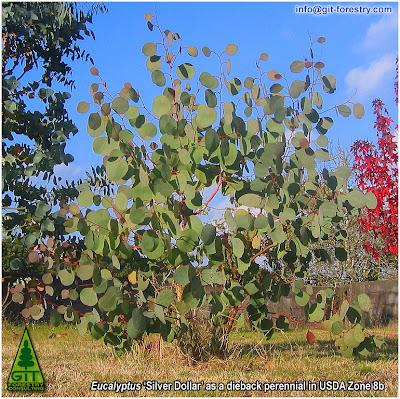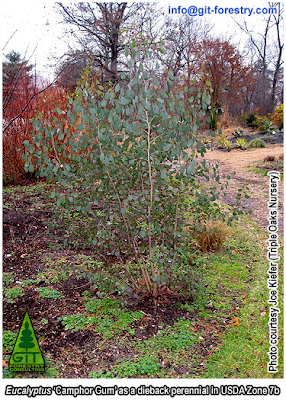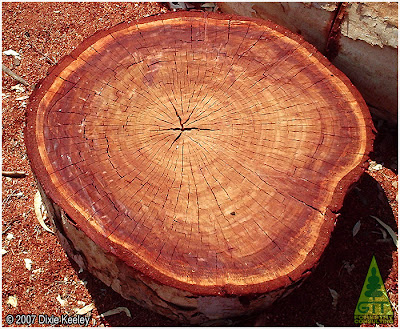Eucalyptus and Snow: Winter views of eucalypt timber plantations in Northwestern Spain
 Fig. 1: Winter view of a 10 year old frost tolerant Eucalyptus cultivated forest at 800 m above sea level in Galicia (Northwestern Spain). (Click image to enlarge)
Fig. 1: Winter view of a 10 year old frost tolerant Eucalyptus cultivated forest at 800 m above sea level in Galicia (Northwestern Spain). (Click image to enlarge)
Gustavo Iglesias Trabado 
GIT Forestry Consulting - Consultoría y Servicios de Ingeniería Agroforestal - www.git-forestry.com - EUCALYPTOLOGICS

Some of the following cold hardy Eucalyptus timber plantations have resisted brief events of -10ºC as absolute minimum temperature, -8ºC as average of extreme minima, 45 to 85 frost events per year, 9 events of winds +95 km/h and several snow storms. Climatic history shows extreme maximum periods of frost risk spanning for 205 days/year (from late October to mid April), but there is a significative variation every year for each location both for severity of winter events and degrees of damage and recovery.

GIT Forestry Consulting - Consultoría y Servicios de Ingeniería Agroforestal - www.git-forestry.com - EUCALYPTOLOGICS

Some of the following cold hardy Eucalyptus timber plantations have resisted brief events of -10ºC as absolute minimum temperature, -8ºC as average of extreme minima, 45 to 85 frost events per year, 9 events of winds +95 km/h and several snow storms. Climatic history shows extreme maximum periods of frost risk spanning for 205 days/year (from late October to mid April), but there is a significative variation every year for each location both for severity of winter events and degrees of damage and recovery.
 Fig. 1: Winter view of a 10 year old frost tolerant Eucalyptus cultivated forest at 800 m above sea level in Galicia (Northwestern Spain). (Click image to enlarge)
Fig. 1: Winter view of a 10 year old frost tolerant Eucalyptus cultivated forest at 800 m above sea level in Galicia (Northwestern Spain). (Click image to enlarge) Fig. 2: Winter view of a 7 year old frost tolerant Eucalyptus timber plantation at 750 m above sea level in Galicia (Northwestern Spain). (Click image to enlarge)
Fig. 2: Winter view of a 7 year old frost tolerant Eucalyptus timber plantation at 750 m above sea level in Galicia (Northwestern Spain). (Click image to enlarge) Fig. 3: Winter view of 3 year old frost tolerant Eucalyptus saplings at 700 m above sea level in Galicia (Northwestern Spain). (Click image to enlarge)
Fig. 3: Winter view of 3 year old frost tolerant Eucalyptus saplings at 700 m above sea level in Galicia (Northwestern Spain). (Click image to enlarge) Fig. 4: Winter view of a 5 year old frost tolerant Eucalyptus timber plantation at 600 m above sea level in Galicia (Northwestern Spain). (Click image to enlarge)
Fig. 4: Winter view of a 5 year old frost tolerant Eucalyptus timber plantation at 600 m above sea level in Galicia (Northwestern Spain). (Click image to enlarge)Some key factors for a successful cultivation of cold hardy Eucalyptus for timber production
- Careful choice of Eucalyptus species suitable for winter conditions in the area of introduction and suitable for target industrial lines. Results from well designed comparative species survival and growth trials for the area of introduction are good indicators.
- Careful choice of seed provenances within the most desirable Eucalyptus species. Results from well designed provenance trials able to quantify best growth and cold tolerance for the area of introduction are good indicators.
- Use of genetically improved Eucalyptus plant stock if available, as it normally yields better growth rates and improved physical or chemical timber properties.
- Good matching of species to site, preferring sheltered from sustained chilly winds and and as sunny as possible areas with Southern exposure, better over soils of moderate depth and fertility.
- Proper site prepation to encourage as fast establishment of the tender Eucalyptus seedlings as possible. Well developed root systems on deep laboured soil tend to stand better temporary freezing of the most superficial soil layers.
- Proper planting schedule to allow quick growth during the first year. A good height growth over the coldest layer of air near soil tends to increase survival rates to radiational frost.
- Proper understorey control during the first years to minimise competence and allow as quick formation of less fragile woody tissue as possible. Even the most resistant plant material is at risk of damage due to impredictable extreme climatic events. However survival and recovery from damage are better once eucalypts reach a certain size.
- Regular monitoring of weather events and symptoms of cold induced damage (leaf injuries, dessication, bark cracking, newest growth burns, form defects, etc).
Interesting links
Cold hardy Eucalyptus timber production in Galicia (I)
Eucalyptus Highland Forests in Northwestern Spain and Portugal (II)
Eucalyptus globulus. Blue Gum Eucalypt Coastal Forests in Northwestern Iberia
Eucalyptus nitens. Shining Gum Eucalypt Highland Forests in Northwestern Iberia
Eucalyptus macarthurii. Camden Woollybutt Highland Forests in Northwestern Iberia
Eucalyptus delegatensis. Tasmanian Oak Highland Forests in Northwestern Iberia
Eucalyptus dalrympleana. Mountain White Gum Highland Forests in Northwestern Iberia
(more to come, we are hunting them all!)
Have you seen the Giant Eucalyptus Movie?
 Subscribe to receive EUCALYPTOLOGICS via e-mail
Subscribe to receive EUCALYPTOLOGICS via e-mail
Eucalyptus Highland Forests in Northwestern Spain and Portugal (II)
Eucalyptus globulus. Blue Gum Eucalypt Coastal Forests in Northwestern Iberia
Eucalyptus nitens. Shining Gum Eucalypt Highland Forests in Northwestern Iberia
Eucalyptus macarthurii. Camden Woollybutt Highland Forests in Northwestern Iberia
Eucalyptus delegatensis. Tasmanian Oak Highland Forests in Northwestern Iberia
Eucalyptus dalrympleana. Mountain White Gum Highland Forests in Northwestern Iberia
(more to come, we are hunting them all!)
Have you seen the Giant Eucalyptus Movie?
Subscribe to receive EUCALYPTOLOGICS via RSS
© 2007 Gustavo Iglesias Trabado. Please contact us if you want to use all or part of this text and photography elsewhere. We like to share, but we do not like rudeness.



















